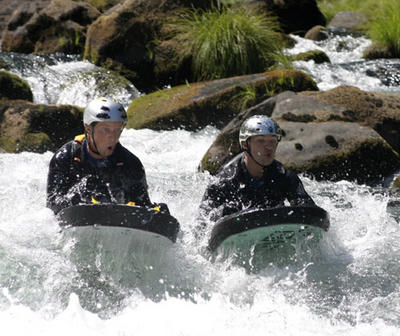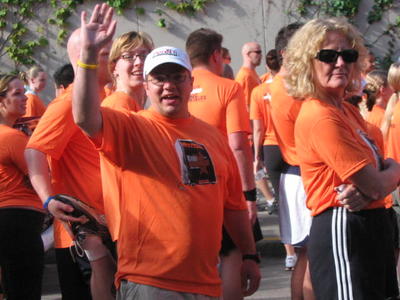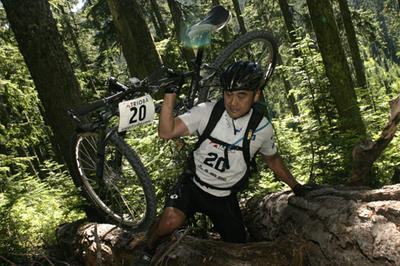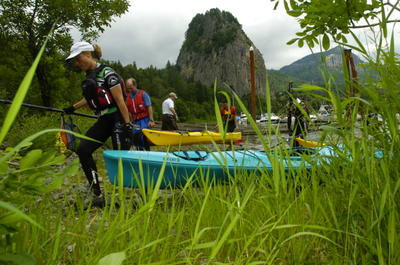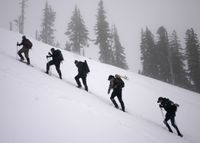I spent Feb. 21 through 28 making pictures in the Mexican state of Hidalgo. There, Ernesto Rivas, a Mexico City adventure racer, has put on an enormously popular multi-sport endurance race for the past three years. His race runs over four days, and includes three stages. The fist stage is 12 hours long, the second is 24, and the third is six.
My friends from Big Bear, Calif., adventure racers Karen Lundgren and Paul Romero, told me back in September 2004 about Ernesto, and that I should photograph his race. I contacted Ernesto and he welcomed me with open arms.JOURNEY DAY ONE -- Monday, Feb. 21, 2005
Getting to the race start took 22 hours of travel from my house in Vancouver, Wash. (the suburbs of Portland, Oregon). I flew from Portland to Los Angeles, and from Los Angeles to Mexico City. Ernesto had a large, modern bus at the airport to take racers and media on the five-hour drive to the race start at a mining camp/company town called Otongo in the state of Hidalgo.
JOURNEY DAY TWO -- Tuesday, Feb. 22, 2005
Our bus arrived at Otongo at 4 a.m. My stomach had lurched for the final hour of our trip. Several hours of tight curves and livestock-sized pot holes had shaken me deeply. Relieved to be off the bus, I shuffled around the hotel parking lot taking deep breaths while others tried to figure out where our rooms were. The only help found at the front desk was a security guard who was not about to wake anyone up to get us our keys. It looked like we'd all have to crash in the lobby, and nobody was awake enough to care. Minutes later, Ernesto arrived. "Ernesto!" those who knew him shouted. "Good to see you! Where are our rooms?" "I'm not Ernesto," the Ernesto-looing man said. "I'm his twin brother." That did not register well in our tired minds. "When did you guys get here?" the very Ernesto-looking non-Ernesto asked. "Just a few minutes ago," racers answered. "And there's nobody here to give you your keys?" he asked. "No," he was told. "I'll get somebody," he said. "By the way, all the international media has a house at the bottom of the hill. If you're international media, come with me." Lisa and Dan from Adventure Sports Magazine followed the non-Ernesto, and I just stood there in the lobby. I wondered, am I international media? Lisa and Dan and the non-Ernesto were halfway across the parking lot already. Well, I'm not with a team, I told myself. And I gues I am media, I'm here to take pictures. But am I international media? Maybe I am. This is Mexico. I'm not Mexican. Better go ask. I hurried across the lot as they were opening the doors to a pickup and piling in. "Yes," Lisa and Dan told me. "Hop in." We were driven down the hill to our house -- a duplex really. It had three bedrooms already occupied by international media, so Lisa and Dan and I were assigned cots in the living room. I laid down and was asleep almost immediately. Woke up later this morning to the sounds of birds I did not recognize. Opened the door of our house and saw vegetation I did not recognize. Every tree and bush seemed to have a flower on it. This village of Otongo sits near the top of a mountain, and the valley is clearly visible at least a thousand feet below. The peaks are jagged but covered in vegetation. I hike up to the hotel and see many faces I remember from the Subaru Primal Quest adventure race in September 2004 in Washington state. Several of them recognize me and call to me by name. A captain's meeting was to begin in the auditorium right away. Where's the auditorium? Back down the hill, and then some. I hike down with Karen Lundgren, captain of team SOLE Custom Footbeds. In March 2004, I volunteered for West Coast Adventure Racing's first-ever event, set in San Diego County, California. A few months later, in June 2004, I attended Karen's adventure racing training camp at Big Bear, California. I'd seen her again at Primal Quest, but this was the first time we'd seen eachother since then. We caught up on the walk down. The meeting began and I started taking pictures. The Mexican television network Televisa had the stage lit up beautifully, so I didn't use my flash. I got shots of the race officials, then got shots of teams transposing checkpoints onto their maps from the master maps. The meeting broke up. Instead of heading up the hill to the hotel, I roamed the streets of the town for a few hours, making pictures as I went. Later that night, the welcome dinner kicked things off in memorable fashion. A man with a flaming cow on his head marched around the party area. The cow had a variety of fireworks attached. People ran for cover left and right whenever the cow approached. Once the party ended, Ernesto hosted a quick media meeting to tell us what we were in for. It all sounded pretty seat-of-the-pants, but I was eager to get going.
JOURNEY DAY THREE-- Wednesday, Feb. 23, 2005
Race Stage One, 12 Hours, Otonogo to Huejutla
Race start was at a very gritty manganese mine. Our media van tried to stay ahead of the racers as they made their way to a slot canyon, but the athletes were sprinting down hillsides that road engineers wisely contoured around. As a result, we missed most of the teams in the slot canyon section. Those we did see looked happy and eager to get on with it. I stayed at the top of the canyon to shoot teams before they entered the narrows. Others went downstream and came back soaking wet. One photographer even submerged a camera. I made a mental note -- next race, bring a dry bag from the kayak gear! Then I could have gone down with no worries. Back in the van and we rushed to a town along a river to watch a kayak leg. The school kids were officially out of class to cheer for the athletes. This resulted in a noisy scene at the riverside. Trees had been laid across the channel so teams would have to jump out and lift their inflatable kayaks over the obstacle. A good time was inevitable, as were good photos. One team had to drop out at this point, and they were stuffed into the media van for the ride to the finish line in the city of Huejutla. Motion sickness reared its ugly head again. One of the racers who'd dropped out had to get out and throw up. I was so close to being right behind her! Luckily, I kept it in and we arrived in Huejutla to find thousands of locals at the central plaza, waiting at the finish line for the teams to show up. Got my hotel assignment -- rooming not with Adventure Sports Magazine anymore, but a father/daughter film crew from the Yukon Territory of Canada, Allan and Angela Code. I shot the teams as they arrived, then retired to the hotel lobby to download all the photos of the day. As my card reader flashed red, reading the day's work, I watched Mexican soccer on the televsion. What a great adventure!
JOURNEY DAY FOUR-- Thursday, Feb. 24, 2005
Race Stage Two, 24 Hours, Molongo to Mineral del Chico
First thing I did this morning was find a pharmacy to get my hands on some dramamine. No more car sickness! The medicine worked really well for about an hour and a half. Lucky for me, that's when we arrived in the town of Molongo. The race wasn't going to run through the town, but the people were so eager to welcome the racers, that organizers agreed to have the athletes walk down the main street. Kids were again officially out of school, and ready to cheer. Many had flags of the nations the athletes came from. I got some great shots of a group of kids with Mexican flags. As the group paraded through town, I searched for a high angle and found one. A second-story window was in a perfect spot, where the lineup was to take a right turn. I asked the owner of the house if I could go up, and she escoreted me to the exact spot I had in mind. It was perfect! But the shot I got after the athletes passed was even better. The mother of the owner was in a window to my left, watching the same scene unfold. Lost in her own thoughs, she didn't notice me aiming my lens at her. The resulting photo is one of my favorites from the whole trip. Next we went to a nearby lake where the 24-hour race was to begin with a swim. got OK photos of the start, but better ones of racers climbing out of the water at the end of the swim. Back in the van and we hurried across the valley to a trek/bike transition area. We beat all the teams there, so had a great time shooting nearly everyone. A rare occasion! The light kept changing as clouds came and went. Thunder even rolled across the hills for a time, and the heavens opened up and dumped a bunch of rain. Eventually we left for a second lake, where teams were to transition from bikes to kayaks. The light continued to change, but this time for the better. The photographers in the van were getting antsy. Many stops were requested, but few were granted. When we finally got close to the second lake, a rainbow lit up the sky. Incredible! Down at the lakeside, team Nokia was lamenting the recent rain, because it had tuned the silty soil to something like peanut butter in stickyness. One of their teammates got injured trying to force his way through the muck. They were out of the race. We didn't know it at the time, but so were we. The sun was fading fast as we tried to find a way to get to where the boats were. by the time we got there, it was dark. We were out of business. So we got back in the van and went to Mineral del Chico. At a camp outside of town, the media was assigned a cabin. I immediately began to download the work of the day off my memory cards. I slept very happily in the loft.
JOURNEY DAY FIVE-- Friday, Feb. 25, 2005
Race Stage Two, 24 hours, Molongo to Mineral del Chico
I believe I hiked at least 10 miles today with most of my gear. The hike out to the rappell was three or four miles, I think. Once there (I arrived two hours after I started hiking), the views were stunning. Some of the ropes crew tried out the tyrolean traverse and the light was good then. By the time teams came, clouds blocked the view. Athletes took a ride on a rope having no idea where it would end! I started to feel sick on the drive back to Chico. I took a shower and a three-hour nap. I didn't want to miss the finish line party in Chico, so I headed down to town from our camp up on the hill. It must be two miles from camp to the plaza. Hungry and tired, I shuffeled into a restaurant for dinner. Forty pesos later, I felt pretty good. I hung out a bit with my Yukon friends. They recognized I was in bad shape and did a great job taking care of me. At times, covering an adventure race is miserable. But just like the racers, we all have great stories to tell in the weeks, months and years that follow.
JOURNEY DAY SIX -- Saturday, Feb. 26, 2005
Race Stage Three, six hours, Mineral del Chico to Pachuca
The final stage of the race today was FAST! The highlight for me was the town of Real del Monte, or Mineral del Monte, depending on which map you use. Racers rode their bikes through the mining town. It has tiny, winding streets and much colonial architecture. My dad told me befor ethis trip to watch for a town he could live in. I don't think a finer Mexican town exists. We got from Mineral del Monte to Pachuca in about 30 minutes on freeway-like roads. Soon we were in a traffic jam near the center of town. Streets around the plaza had been closed for the finish, so traffic was a mess. We walked the final four blocks to the plaza, just in time to see the winning team, Montrail, arrive. This crowd was many times larger than the one in Huejutla. Again, kids were in the streets cheering the athletes. It was a weekend, so they probably didn't have to be there, but they were, all in their school uniforms and waving flags. Eventually we got to our hotel. I roomed again with my Yukon friends. There were two parties that night. The awards ceremony party was at the fairgrounds in Pachuca, right across the street from the Plaza de Toros. After that, the real party took place in the basement of our hotel. The tequila flowed all night long. Not really my scene, I chatted with a few people I knew, then went to my room to download my final photos. I was in bed by 11 p.m.
JOURNEY DAY SEVEN --Sunday, Feb. 27, 2005
The race organization bus from Pachuca to the Mexico City airport was full, so I rode in a luggage pickup with one of the guys I'd been talking to all week. We had a good time chatting about all that we'd seen in the past several days. I hung out in the airport for about two hours, thinking I would save money by not getting a hotel room. I eventually gave up and got a skycap to show me how to catch a hotel van out front of the airport. About 30 minutes later, I arrived at the Mexico City East Holiday Inn. I walked across the street to Wal-mart and bought some clean clothes. Ten bucks outfitted me rather nicely. Had dinner, went to bed. Early van to the airport tomorrow!
JOURNEY DAY EIGHT -- Monday, Feb. 28, 2005
Caught the hotel van to the airport at 4 a.m. Got through security and checked in for flight. got to my gate and settled in for my flight to be called. First leg was four and a half hours to San Francisco. Got to see Copper Canyon and Los Angeles on the way. Second leg was about two hours. Clouds blocked the view, and I arrived in Portland in the rain. What an amazing trip! And what a privelige to be living my dream.
 Photo by Mike Bitton
Photo by Mike Bitton
